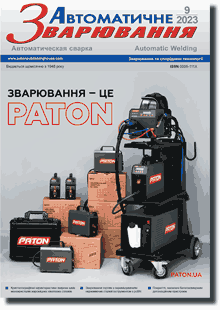| 2023 №09 (02) |
DOI of Article 10.37434/as2023.09.03 |
2023 №09 (04) |

"Avtomatychne Zvaryuvannya" (Automatic Welding), #9, 2023, pp. 17-20
Welding-technological properties of flux-cored wire with boron-containing binder in the charge
I.O. Ryabtsev, A.A. Babinets, I.P. Lentyugov
E.O. Paton Electric Welding Institute of the NAS of Ukraine. 11 Kazymyr Malevych Str., 03150, Kyiv, Ukraine. E-mail: office@paton.kiev.uaIn order to improve the performance of metal deposited with PP-Np-50Kh2MNSGF flux-cored wire, boron-containing FKhB-1 binder was added to the wire charge in such a way as to obtain boron content on the level of 0.01 % in the deposited metal. The effect of adding FKhB-1 binder to the flux-cored wire charge on its welding-technological properties was studied experimentally. It was found that application of boron-containing binder in the flux-cored wire charge does not impair its welding-technological properties, boron microalloying leading to refinement of the deposited metal structure and increases its hardness from HRC 53…57 to HRC 60…62 at the same content of other alloying elements. Developed PP-Np-50Kh2MNSGF flux-cored wire is proposed for deposition of wear-resistant layers for protection of parts of special machines and mechanisms in mining, metallurgical and other industries, operating under the difficult conditions of abrasive wear in combination with intense shock loads. 11 Ref., 2 Tabl., 4 Fig.
Keywords: arc surfacing, flux-cored wire, microalloying, welding-technological properties, deposited metal, deposited metal formation
Received: 30.06.2023
References
1. Baker, T.N. (2016) Microalloyed steels. Ironmaking & Steelmaking, 43(4), 264-307. https://doi.org/10.1179/1743281215Y.00000000632. Lyakishev, N.P., Pliner, U.L., Lappo, S.I. (1986) Boron-containing steels and alloys. Moscow, Metallurgiya [in Russian].
3. Manyak, N.A., Manyak, L.K. (2002) Influence of boron on structure and toughness of low-alloyed steel. Metall i Lityo Ukrainy, 5-6, 23-25 [in Russian].
4. Proidak, Yu.S., Manydyn, V.S., Isaieva, L.E. et al. (2020) Microalloying of low-carbon steel with boron and method of determination of dissolved boron effective concentration Teoriya i Praktyka Metalurgii, 1, 18-23 [in Ukrainian]. https://doi.org/10.34185/tpm.1.2020.02
5. Mujagic, D., Imamovic, A., Hadzalic, M. (2021) The influence of microalloying with boron on properties of austenite stainless steel X8CrNiS18-9. Int. J. of Adv. Res., 9, 695-700. https://doi.org/10.21474/IJAR01/13596
6. Xiao, L.-J., Qiu. S.-T., Liu, J.-Q., Gan, Y. (2008) Research and application status of boron microalloying in high quality steel plate. Journal of Iron and Steel Research, 20(5), 1-4.
7. Zhudra, A.P., Krivchikov, S.Yu., Petrov, V.V. (2004) Selection of boron-containing charge materials for the core of fluxcored wire. The Paton Welding J., 4, 51-52.
8. Krivchikov, S.Yu. (2012) Modification by boron of deposited metal of white cast iron type. The Paton Welding J., 6, 19-21.
9. Maksimov, S.Yu., Machulyak. V.V., Sheremeta, A.V., Goncharenko, E.I. (2014) Investigation of influence of microalloying with titanium and boron of weld metal on its mechanical properties in underwater welding. The Paton Welding J., 6-7, 76-79. https://doi.org/10.15407/tpwj2014.06.15
10. Babinets, A.A., Ryabtsev, I.O. (2021) Influence of modification and microalloying on deposited metal structure and properties (Review). The Paton Welding J. https://doi.org/10.37434/tpwj2021.10.01
11. Babinets, A.A., Ryabtsev, I.O., Lentyugov, I.P., Bogaichuk, I.L. (2022) Influence of microalloying with boron on the structure and properties of deposited metal of the type of tool steel 25Kh5FMS. The Paton Welding J., 6, 3-10. https://doi.org/10.37434/tpwj2022.06.01
Advertising in this issue:
The cost of subscription/purchase order journals or individual articles
| Journal/Currency | Annual Set | 1 issue printed |
1 issue |
one article |
| TPWJ/USD | 384 $ | 32 $ | 26 $ | 13 $ |
| TPWJ/EUR | 348 € | 29 € | 24 € | 12 € |
| TPWJ/UAH | 7200 UAH | 600 UAH | 600 UAH | 280 UAH |
| AS/UAH | 1800 UAH | 300 UAH | 300 UAH | 150 UAH |
| AS/USD | 192 $ | 32 $ | 26 $ | 13 $ |
| AS/EUR | 180 € | 30 € | 25 € | 12 € |
| SEM/UAH | 1200 UAH | 300 UAH | 300 UAH | 150 UAH |
| SEM/USD | 128 $ | 32 $ | 26 $ | 13 $ |
| SEM/EUR | 120 € | 30 € | 25 € | 12 € |
| TDNK/UAH | 1200 UAH | 300 UAH | 300 UAH | 150 UAH |
| TDNK/USD | 128 $ | 32 $ | 26 $ | 13 $ |
| TDNK/EUR | 120 € | 30 € | 25 € | 15 € |
AS = «Automatic Welding» - 6 issues per year;
TPWJ = «PATON WELDING JOURNAL» - 12 issues per year;
SEM = «Electrometallurgy Today» - 4 issues per year;
TDNK = «Technical Diagnostics and Non-Destructive Testing» - 4 issues per year.









